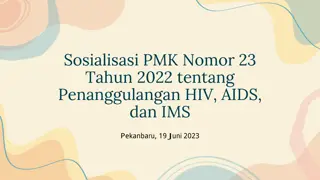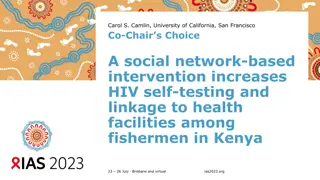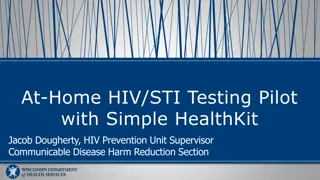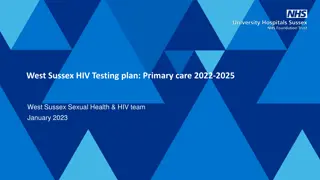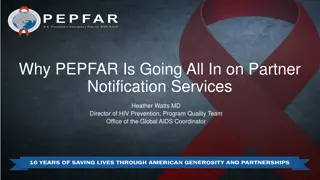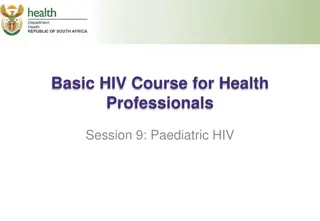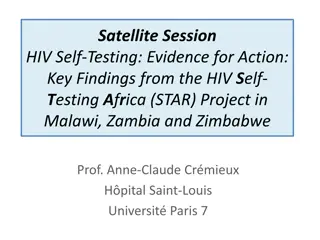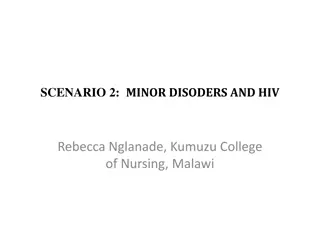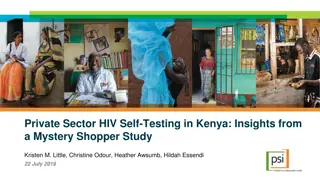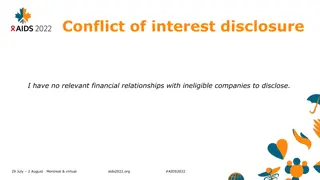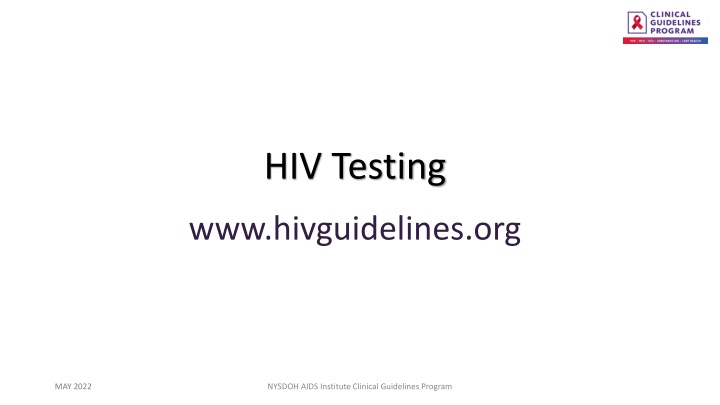
HIV Testing
The NYSDOH AI HIV Testing Guidelines provide clinicians in New York State with up-to-date information on HIV testing policies and practices. The guidelines emphasize the importance of immediate linkage to care for individuals diagnosed with HIV, rapid initiation of antiretroviral therapy (ART), and compliance with New York State laws and regulations regarding HIV testing and reporting. Clinicians are encouraged to follow the standard 3-step HIV testing algorithm recommended by the CDC and the NYSDOH AI to increase HIV testing rates and ensure timely referral for treatment or prevention services based on test results. The guidelines also highlight the importance of rapid ART initiation for all individuals diagnosed with HIV and provide information on Wadsworth Center Bloodborne Viruses Laboratory services.
Download Presentation

Please find below an Image/Link to download the presentation.
The content on the website is provided AS IS for your information and personal use only. It may not be sold, licensed, or shared on other websites without obtaining consent from the author. If you encounter any issues during the download, it is possible that the publisher has removed the file from their server.
You are allowed to download the files provided on this website for personal or commercial use, subject to the condition that they are used lawfully. All files are the property of their respective owners.
The content on the website is provided AS IS for your information and personal use only. It may not be sold, licensed, or shared on other websites without obtaining consent from the author.
E N D
Presentation Transcript
HIV Testing www.hivguidelines.org MAY 2022 NYSDOH AIDS Institute Clinical Guidelines Program
A New HIV Diagnosis is a Call to Action A New HIV Diagnosis is a Call to Action In support of the NYSDOH AI January 2018 call to action for patients newly diagnosed with HIV, the Medical Care Criteria Committee stresses the following: Immediate linkage to care is essential for any individual diagnosed with HIV. For the individual with HIV, ART dramatically reduces HIV-related morbidity and mortality. Viral suppression helps prevent HIV transmission to sex partners of people with HIV and prevents perinatal transmission of HIV. ART initiation is urgent if the newly diagnosed patient is pregnant, has acute HIV infection, is 50 years old, or has advanced HIV disease. Every effort should be made to initiate ART immediately for these patients, ideally on the same day as diagnosis. All clinical care settings should be prepared, either on-site or with a confirmed referral, to support patients in initiating ART as rapidly as possible after diagnosis. MAY 2022 NYSDOH AIDS Institute Clinical Guidelines Program www.hivguidelines.org
Purpose of This Guideline Purpose of This Guideline Provide clinicians in NYS with up-to-date information on HIV testing policies and practices. Ensure awareness of and access to the standard 3-step HIV testing algorithm recommended by the CDC and the NYSDOH AI. Increase HIV testing in NYS to increase the number of people who know their HIV status. Ensure that clinicians recognize and respond to HIV testing as a gateway to care, such that an HIV diagnosis prompts a referral for HIV treatment and a negative HIV test result prompts a referral for HIV prevention services, including PrEP and PEP. Emphasize that rapid ART initiation is the standard of care for all individuals diagnosed with HIV. Provide clinicians with information about the Wadsworth Center Bloodborne Viruses Laboratory services. MAY 2022 NYSDOH AIDS Institute Clinical Guidelines Program www.hivguidelines.org
New York State Law New York State Law Clinicians must perform diagnostic HIV laboratory tests in full compliance with New York State (NYS) HIV/AIDS Laws and Regulations. Clinicians must report confirmed cases of HIV according to NYS law. Additional information regarding testing procedures and regulations is available from the NYSDOH Wadsworth Center (518-474-2163). MAY 2022 NYSDOH AIDS Institute Clinical Guidelines Program www.hivguidelines.org
NYS Public Health Law HIV Testing Requirements NYS Public Health Law HIV Testing Requirements (effective June 2018) (effective June 2018) Who to test: NYS law mandates that physicians offer an HIV test to all patients 13 years old (or younger with risk) if a previous test is not documented, even in the absence of symptoms consistent with acute HIV. Consent: HIV testing remains voluntary, and patients have the right to refuse an HIV test, but obtaining written or oral consent for testing is no longer required in any setting. At a minimum, patients must be advised verbally that an HIV test is going to be performed. Minor consent: Minors may consent to their own HIV testing, treatment, and/or prevention services (such as PrEP and PEP) without parent/guardian involvement. MAY 2022 NYSDOH AIDS Institute Clinical Guidelines Program www.hivguidelines.org
NYS Public Health Law HIV Testing Requirements NYS Public Health Law HIV Testing Requirements (effective June 2018), (effective June 2018), continued continued Pre-test counseling: Before HIV testing is performed, information about HIV must be provided verbally, in writing, through signage, or in any other patient-friendly audio- visual format. Placing a NYSDOH HIV testing clinic poster in a visible location or providing patients with the NYSDOH patient brochure on HIV testing are easy and convenient ways to provide patients with this necessary information. Post-test counseling: When testing indicates an HIV infection: The clinician who ordered the HIV testing (or their representative) must provide the result to the patient, ensure the patient is scheduled for follow-up HIV care, and educate the patient on HIV transmission. When testing indicates no HIV infection: The patient must be informed of the result and provided education on prevention options, including PrEP and PEP. This information may be in the form of written materials, such as the NYSDOH Information on Non-reactive (Negative) HIV Test Results. When testing indicates inconclusive or incomplete results: The patient must be informed of the result and have an additional specimen collected to repeat the HIV testing algorithm. MAY 2022 NYSDOH AIDS Institute Clinical Guidelines Program www.hivguidelines.org
NYS Public Health Law HIV Testing Requirements NYS Public Health Law HIV Testing Requirements (effective June 2018), (effective June 2018), continued continued Testing in pregnancy: HIV testing should be offered to pregnant individuals as early as possible during pregnancy and again during the third trimester for those who previously tested negative. Partner services: Clinicians must explain to all individuals with a new diagnosis of HIV the importance of notifying any sex or needle-sharing partners. Throughout the notification process, names or personal identifiers, including the dates of exposure, are never revealed to partners. The anonymity and privacy of the original patient is the highest priority. For more information, see NYSDOH Information on Partner Services. Nomenclature:In NYS, the terms clinical/symptomatic HIV illness or AIDS, AIDS or HIV-related illness, and other similar terms shall mean laboratory-confirmed HIV diagnosis (source: NYSDOH June 2016 Policy Statement: Defining Program Eligibility by HIV Status). MAY 2022 NYSDOH AIDS Institute Clinical Guidelines Program www.hivguidelines.org
NYS Public Health Law HIV Testing Requirements NYS Public Health Law HIV Testing Requirements (effective June 2018), (effective June 2018), continued continued Reporting requirements: NYS Public Health Law Article 21 (Chapter 163 of the Laws of 1998) requires the reporting of individuals with HIV as well as AIDS to the NYSDOH. The law also requires that reports contain the names of sex or needle-sharing partners known to the medical provider or whom the infected individual wishes to have notified. For more information, see NYSDOH Provider Reporting and Partner Services; also see NYC: How to Report a Diagnosis of HIV or AIDS. The Medical Provider Report Form (PRF) (DOH-4189) must be completed within 7 days of diagnosis for the following individuals: Initial/new HIV diagnosis: First report of HIV antibody positive test results, including cases of acute HIV, which must be submitted within 24 hours Previously diagnosed HIV infection (non-AIDS): Applies to a medical provider who is seeing the patient for the first time Initial/new diagnosis of AIDS: Including <200 CD4 cells/ L or opportunistic infection (AIDS-defining illness) Previously diagnosed AIDS: Applies to a medical provider who is seeing the patient for the first time Known sex or needle-sharing partners of individuals with diagnosed HIV infection The PRF can be completed electronically through the provider portal on the NYSDOH Health Commerce System. For information regarding Provider Portal access or to obtain printed copies of the PRF, call 518-474-4284. MAY 2022 NYSDOH AIDS Institute Clinical Guidelines Program www.hivguidelines.org
HIV Window of HIV Window of Detection Detection MAY 2022 NYSDOH AIDS Institute Clinical Guidelines Program www.hivguidelines.org
Recommendations: HIV Testing With the Recommendations: HIV Testing With the Standard 3 Standard 3- -Step Algorithm Step Algorithm Step 1: HIV-1/2 Antigen/Antibody Immunoassay For initial HIV testing (aka screening ), clinicians should use an HIV-1/2 Ag/Ab immunoassay (formerly known as the 4th-generation test). (A2) For initial testing of newborns or individuals who are in labor, being evaluated for PEP, or unlikely to return for test results, clinicians should use an FDA-approved HIV screening test that provides results within 60 minutes (A2); otherwise, rapid tests are not recommended for step 1 of the standard HIV laboratory testing algorithm. Because all initial HIV tests are subject to false positive results, clinicians should consider all reactive initial test results preliminary and perform appropriate laboratory diagnostic testing to confirm a patient s HIV status. (A1) Clinicians should educate patients about the limitations of in-home testing and emphasize that a laboratory should repeat both nonreactive and reactive results of any in-home HIV testing. (A3) In the case of a nonreactive result, the clinician should discuss goal-oriented, harm-reduction strategies, including PrEP and emergency PEP, with any patient who reports recent or likely ongoing HIV risk exposures or refer the patient for prevention services. (A3) Clinicians should offer repeat HIV testing every 3 months, or sooner if acute HIV is suspected, for as long as an individual remains at high risk of HIV exposure. (A3) MAY 2022 NYSDOH AIDS Institute Clinical Guidelines Program www.hivguidelines.org
Recommendations: HIV Testing With the Recommendations: HIV Testing With the Standard 3 Standard 3- -Step Algorithm, Step Algorithm, continued continued Step 2: HIV-1/HIV-2 Antibody Differentiation Immunoassay Per the standard HIV laboratory testing algorithm, if a reactive result is obtained with an HIV-1/2 Ag/Ab immunoassay test (step 1), clinicians should perform supplemental testing (step 2) with an FDA-approved HIV- 1/HIV-2 Ab differentiation immunoassay. (A1) If the result of the HIV Ab differentiation immunoassay (step 2) is positive for HIV-1 or HIV-2 Abs, the clinician should provide or refer the patient for rapid ART initiation and transmission prevention counseling. (A1) Note: If the HIV Ab differentiation immunoassay result is positive but undifferentiated (i.e., reactive for both HIV-1 and HIV-2), repeat testing may determine if the patient has HIV-1 or HIV-2 infection. MAY 2022 NYSDOH AIDS Institute Clinical Guidelines Program www.hivguidelines.org
Recommendations: HIV Testing With the Recommendations: HIV Testing With the Standard 3 Standard 3- -Step Algorithm, Step Algorithm, continued continued Step 3: HIV-1 Nucleic Acid Testing (qualitative or quantitative HIV RNA testing) If the HIV-1/2 Ab differentiation immunoassay (step 2) result is nonreactive (negative) or indeterminate (neither positive nor negative for HIV-1 or HIV-2), and the lab does not perform reflex testing, the clinician should immediately order HIV-1 RNA NAT (step 3) to detect the presence of HIV-1 RNA and confirm or exclude HIV-1 infection. (A*) If HIV-1 RNA is detected, the clinician should inform the patient of the acute HIV- 1 diagnosis, recommend ART initiation, and prioritize counseling to prevent HIV transmission. (A1) Clinicians should not wait for serologic confirmation of HIV to initiate ART when pregnant individuals are diagnosed with acute HIV infection by HIV-1 NAT; initiation of ART is strongly recommended for pregnant individuals. (A2) To determine the HIV status of an infant born to an individual with HIV-1, clinicians should perform HIV-1 RNA NAT. (A1) MAY 2022 NYSDOH AIDS Institute Clinical Guidelines Program www.hivguidelines.org
HIV Laboratory HIV Laboratory Testing Testing Algorithm Algorithm [a] [a] See next slide for notes. MAY 2022 NYSDOH AIDS Institute Clinical Guidelines Program www.hivguidelines.org
HIV Laboratory Testing Algorithm: Notes HIV Laboratory Testing Algorithm: Notes a. Adapted from CDC 2018 Quick reference guide: Recommended laboratory HIV testing algorithm for serum or plasma specimens and APHL Suggested reporting language for the HIV laboratory diagnostic testing algorithm. b. APHL and CDC continue to recommend that laboratories use an FDA-approved instrumented HIV-1/HIV-2 Ag/Ab immunoassay as the initial assay in the laboratory HIV testing algorithm for serum or plasma due to their superior sensitivity for detecting acute HIV infection. However, the FDA- approved single-use rapid HIV-1/HIV-2 Ag/Ab immunoassay may be used as the initial assay in the laboratory HIV testing algorithm for serum or plasma if an instrumented assay is not available. c. Become familiar with the laboratory s internal testing algorithm and results-reporting policies. Many labs will reflex additional screening steps (such as HIV Ab differentiation immunoassay and HIV RNA) on the original sample without supplemental orders. Other labs may require additional samples or supplemental orders to complete all steps in the algorithm. d. This includes specimens reported as HIV-2 positive with HIV-1 cross-reactivity. e. Further testing may be performed to determine type. f. Per the Geenius package insert, specimens with this final assay interpretation should be retested with a new cartridge. If the final assay interpretation is again HIV-2 indeterminate, it should be reported as such and followed with an HIV-1 NAT. g. Most laboratories reflex directly to an HIV-1 RNA test without requiring an additional test order or new specimen, either by performing the test in- house or referring the specimen to another laboratory. If the laboratory is unable to or does not automatically reflex directly to the RNA test, clinicians should order an HIV-1 RNA test as soon as possible. To reflex directly to an HIV-1 RNA test, a test kit approved by either the FDA or NYSDOH to aid in diagnosing HIV-1 infection is required. If HIV-1 RNA is detected, acute HIV-1 is present, and clinicians should proceed with clinical evaluation. If no HIV-1 RNA is detected, the initial immunoassay result is presumed false positive. h. A negative HIV-1 NAT result and repeatedly HIV-2 indeterminate or HIV indeterminate Ab differentiation immunoassay result should be referred for testing with a different validated supplemental HIV-2 test (antibody test or NAT) if available. Alternatively, redraw and repeat algorithm in 2 to 4 weeks to assess HIV-2 infection. MAY 2022 NYSDOH AIDS Institute Clinical Guidelines Program www.hivguidelines.org
HIV Testing Services and Assistance Available HIV Testing Services and Assistance Available Through the NYSDOH Wadsworth Center Through the NYSDOH Wadsworth Center HIV-1/HIV-2 Diagnostic Testing (Phone: 518-474-2163) HIV-1/2 Ag/Ab testing; plasma and serum HIV-1/HIV-2 supplemental Ab testing of specimens that are reactive on the initial testing assay HIV-1 RNA testing on plasma, serum, and dried blood spots HIV-2 NAT to quantify HIV-2 RNA Assistance with inconclusive HIV test results Confirmatory testing of dried blood spots for HIV testing sites that cannot collect venous blood MAY 2022 NYSDOH AIDS Institute Clinical Guidelines Program www.hivguidelines.org
HIV Testing Services and Assistance Available HIV Testing Services and Assistance Available Through the NYSDOH Wadsworth Center, Through the NYSDOH Wadsworth Center, continued continued HIV Testing for Newborns (Phone: 518-486-9605) HIV testing for all newborns exposed to HIV (HIV-1 and HIV-2) in NYS, free of charge If a sample is reactive for HIV-2 antibodies, the Pediatric HIV Testing Service will perform an RT-PCR test for qualitative detection of HIV-2 RNA (Phone: 518-486-9605) NYSDOH strongly recommends that all NYS birth facilities use the Pediatric HIV Testing Service at the Wadsworth Center, which is free of charge for NYS clinicians providing care for HIV-exposed infants HIV-2 Viral Load Testing (Phone: 518-473-6007) Quantitative and qualitative HIV-2 viral load testing (free of charge), and quantitative detection of HIV-2 RNA in plasma samples for baseline and subsequent monitoring of response to ART in patients with confirmed HIV-2 infection HIV-2 RNA viral load testing during pregnancy. Contact the lab early in the patient s pregnancy to discuss the protocol and timing for testing MAY 2022 NYSDOH AIDS Institute Clinical Guidelines Program www.hivguidelines.org
Key Points: HIV Key Points: HIV- -1/2 Antigen/Antibody 1/2 Antigen/Antibody Immunoassay (Step 1) Immunoassay (Step 1) Become familiar with the laboratory s internal testing algorithm and results-reporting policies. Many labs will reflex additional screening steps (such as HIV Ab differentiation immunoassay and HIV RNA) on the original sample without supplemental orders. Other labs may require additional samples or supplemental orders to complete all steps in the algorithm. When possible, collect blood by venipuncture for laboratory submission. Consult the specimen collection and handling instructions provided by the laboratory to ensure the specimen will be suitable for all tests in the algorithm. As seroconversion proceeds and HIV Abs are produced, p24 is bound in an Ag-Ab complex and becomes more difficult to detect by standard laboratory assays. Serologic assays that detect only p24 Ag are not recommended for any diagnostic purpose and are not available at most clinical laboratories. NYSDOH strongly recommends that all NYS birth facilities use the Pediatric HIV Testing Service at the Wadsworth Center, which is free of charge for NYS clinicians providing care for HIV-exposed infants. For information about this service, contact the Wadsworth Center at 518-486-9605. MAY 2022 NYSDOH AIDS Institute Clinical Guidelines Program www.hivguidelines.org
Reasons for False Positive, False Negative, or Reasons for False Positive, False Negative, or Indeterminate HIV Test Results Indeterminate HIV Test Results False Positive Results False Negative Results Comments Reduced specificity associated with increased assay sensitivity Technical errors, including specimen mix-up or mislabeling, contamination, improper handling, and misinterpretation of results Presence of HIV Abs in recipients of HIV-1 trial vaccines Other rare possibilities: Hypergammaglobulinemia/Abs reactive to cellular components; cross-reactivity with influenza vaccine that causes cross- reactivity with HIV Ab assays (time course for such cross- reactivity remains uncertain) Test is performed during any of the following periods: Eclipse period before detection of Ag or HIV RNA is possible; during acute infection (before seroconversion) when using a method that detects Abs only; during the early stage of seroconversion when using a method that does not detect early (IgM) Abs Technical errors, including specimen mix-up or mislabeling, contamination, improper handling, and misinterpretation of results Other possibilities: Delayed seroconversion in infants, in those who have concurrent acute HCV infection, due to PEP or PrEP use, or due to ART initiation very early during acute HIV; diminished immune response in patients receiving intensive or long-term immunosuppressive therapy; congenital or drug- induced hypogammaglobulinemia or agammaglobulinemia; insufficient host Ab response (e.g., advanced HIV disease); unavailability of Abs due to the formation of Ag-Ab complexes Individual laboratories may have different internal protocols for reporting preliminary HIV test results. Indeterminate, inconclusive, nondiagnostic, and pending confirmation are among the terms used when preliminary results cannot be classified definitively A reactive result on the initial screening test with inconclusive supplemental serologic testing may represent either a false or true positive. The laboratory should be contacted to determine the significance of the nondefinitive results and determine supplemental testing Determining the significance of nondefinitive results is particularly important when testing pregnant individuals, newborn children, and patients with suspected acute HIV or HIV-2 MAY 2022 NYSDOH AIDS Institute Clinical Guidelines Program www.hivguidelines.org
Key Points: HIV Key Points: HIV- -1/HIV Differentiation Immunoassay (Step 2) Differentiation Immunoassay (Step 2) 1/HIV- -2 Antibody 2 Antibody If the Geenius HIV 1/2 Supplemental Assay interpretation is nonreactive or indeterminate for any HIV type (HIV-1, HIV-2, or untypable HIV), test the specimens for HIV-1 RNA, even if the result is HIV-2 indeterminate. Nonspecific reactivity could cause an HIV-2 indeterminate result to occur in some cases. If HIV-1 RNA is not detected and the Geenius Reader interpretation is HIV-2 indeterminate or HIV indeterminate, an HIV-2 NAT may be warranted. MAY 2022 NYSDOH AIDS Institute Clinical Guidelines Program www.hivguidelines.org
Key Point: HIV Key Point: HIV- -1 RNA Nucleic Acid Testing (Step 3) 1 RNA Nucleic Acid Testing (Step 3) If the person being tested is taking antiretroviral agents as PEP, PrEP, or for rapid ART initiation, a false negative result for the HIV-1 RNA test may occur. MAY 2022 NYSDOH AIDS Institute Clinical Guidelines Program www.hivguidelines.org
Recommendation: Diagnosis of HIV Recommendation: Diagnosis of HIV- -2 Infection 2 Infection When HIV-2 antibodies are detected, clinicians should perform a clinical evaluation for HIV-2 infection that is similar in scope to the evaluation of patients with HIV-1. (A1) MAY 2022 NYSDOH AIDS Institute Clinical Guidelines Program www.hivguidelines.org
HIV HIV- -2 Related Services Available Through the 2 Related Services Available Through the Wadsworth Center Wadsworth Center The following services are available through the Wadsworth Center (phone: 518-474-2163): Quantitative detection of HIV-2 RNA in plasma samples for baseline and subsequent monitoring of response to antiretroviral therapy in patients with confirmed HIV-2 infection. HIV-2 RNA viral load testing during pregnancy. Contact the lab early in a patient s pregnancy to discuss the testing protocol and timing. HIV testing for all New York State newborns exposed to HIV (HIV-1 and HIV- 2), free of charge. The Pediatric HIV Testing Service will perform a reverse transcription polymerase chain reaction test for qualitative detection of HIV-2 RNA in all samples positive for HIV-2. Note: HIV-2 phenotypic and genotypic resistance testing is not offered at the Wadsworth Center or commercially available in the United States. MAY 2022 NYSDOH AIDS Institute Clinical Guidelines Program www.hivguidelines.org
FDA FDA- -Approved HIV Approved HIV- -1/2 Ag/Ab Immunoassays for 1/2 Ag/Ab Immunoassays for Step 1 of the CDC Recommended Laboratory HIV Testing Step 1 of the CDC Recommended Laboratory HIV Testing Algorithm for Serum or Plasma Specimens Algorithm for Serum or Plasma Specimens Test Abbott ARCHITECT HIV Ag/Ab Combo (Abbott Laboratories) FDA-approved 2010 ADVIA Centaur HIV Ag/Ab Combo (CHIV) Assay (Siemens Healthcare Diagnostics) FDA-approved 2015 BioPlex 2200 HIV Ag-Ab Assay (Bio-Rad Laboratories) FDA-approved 2015 Method and Specimens CMIA Serum, plasma Does not differentiate detection of Ag and Ab CMIA Serum, plasma Does not differentiate detection of Ag and Ab Multiplex flow immunoassay Serum, plasma Separately detects HIV-1 Ag, HIV-1 Ab, and HIV-2 Ab MAY 2022 NYSDOH AIDS Institute Clinical Guidelines Program www.hivguidelines.org
FDA FDA- -Approved HIV Approved HIV- -1/2 Ag/Ab Immunoassays for 1/2 Ag/Ab Immunoassays for Step 1 of the CDC Recommended Laboratory HIV Testing Step 1 of the CDC Recommended Laboratory HIV Testing Algorithm for Serum or Plasma Specimens, Algorithm for Serum or Plasma Specimens, continued continued Test GS HIV Combo Ag/Ab EIA (Bio-Rad Laboratories) FDA-approved 2011 Method and Specimens EIA Serum, plasma Does not differentiate detection of Ag and Ab ECLIA Serum, plasma Does not differentiate detection of Ag and Ab Immunometric assay Serum, plasma Does not differentiate detection of Ag and Ab Elecsys HIV combi PT (Roche Diagnostics) FDA-approved 2017 VITROS Immunodiagnostic Products HIV Combo (Ortho-Clinical Diagnostics) FDA-approved 2017 MAY 2022 NYSDOH AIDS Institute Clinical Guidelines Program www.hivguidelines.org
Characteristics of FDA Characteristics of FDA- -Approved Rapid HIV Tests Approved Rapid HIV Tests Test (manufacturer) Sensitivity (95%) Specificity (95%) Whole blood: 99.7% Serum: 99.7% Plasma: 99.7% Whole blood: 99.9% Serum: 99.9% Plasma: 99.9% Chembio SURE CHECK HIV 1/2 Assay (Chembio Diagnostic Systems) Detection: HIV-1/2 Abs Use: POC, lab Specimens: Whole blood, serum, plasma CLIA category: Waived; whole blood only Oral fluid: 98.9% Fingerstick whole blood: 99.8% Venous whole blood: 99.9% Plasma: 99.9% Serum: 99.9% Whole blood: 99.7% Serum: 99.7% Plasma: 99.7% Fingerstick whole blood: 100% Oral fluid: 99.9% Venous whole blood: 99.9% Plasma: 99.9% Serum: 99.9% Whole blood: 99.9% Serum: 99.9% Plasma: 99.9% Chembio DPP HIV 1/2 Assay (Chembio Diagnostic Systems) Detection: HIV-1/2 Abs Use: POC, lab Specimens: Oral fluid, whole blood, plasma, serum CLIA category: Waived; oral fluid and whole blood Chembio HIV 1/2 STAT-PAK Assay (Chembio Diagnostic Systems) Detection: HIV-1/2 Abs Use: POC, lab Specimens: Whole blood, serum, plasma CLIA category: Waived; whole blood only MAY 2022 NYSDOH AIDS Institute Clinical Guidelines Program www.hivguidelines.org
Characteristics of FDA Characteristics of FDA- -Approved Rapid HIV Tests, Approved Rapid HIV Tests, continued continued Test (manufacturer) Sensitivity (95%) Specificity (95%) Whole blood: 99.9% Serum: 99.9% Plasma: 99.9% Fingerstick whole blood: 99.8% Venipuncture whole blood: 99.7% Plasma: 99.7% Serum: 99.6% Abbott Determine HIV-1/2 Ag/Ab Combo (Abbott) Detection: HIV-1 p24 Ag, HIV-1/2 Abs Use: POC, lab Specimens: Whole blood, serum, plasma CLIA category: Waived; fingerstick whole blood only Fingerstick whole blood: 98.9% Venipuncture whole blood: 99.9% Plasma: 99.9% Fingerstick whole blood: 99.0% (people at low risk of HIV) and 99.9% (people at high risk of HIV) Venipuncture whole blood: 100% Plasma: 100% INSTI HIV-1/HIV-2 Antibody Test (bioLytical Laboratories) Detection: HIV-1/2 Abs Use: POC, lab Specimens: Whole blood, plasma CLIA category: Waived; fingerstick whole blood only MAY 2022 NYSDOH AIDS Institute Clinical Guidelines Program www.hivguidelines.org
Characteristics of FDA Characteristics of FDA- -Approved Rapid HIV Tests, Approved Rapid HIV Tests, continued continued Test (manufacturer) Sensitivity (95%) Specificity (95%) Oral fluid: 99.3% Whole blood: 99.6% Plasma: 99.6% Oral fluid: 99.8% Whole blood: 100% Plasma: 99.9% OraQuick ADVANCE Rapid HIV-1/2 Antibody Test (OraSure Technologies) Detection: HIV-1/2 Abs Use: POC, lab Specimens: Oral fluid, whole blood, plasma CLIA category: Waived; oral fluid and whole blood Whole blood: 100% Serum: 100% Plasma: 100% Whole blood: 99.7% Serum: 99.8% Plasma: 99.8% Uni-Gold Recombigen HIV-1/2 (Trinity Biotech) Detection: HIV-1/2 Abs Use: POC, lab Specimens: Whole blood, serum CLIA category: Waived; whole blood only MAY 2022 NYSDOH AIDS Institute Clinical Guidelines Program www.hivguidelines.org
Need Help? Need Help? NYSDOH AIDS Institute Clinical Guidelines Program www.hivguidelines.org
Access the Guideline Access the Guideline www.hivguidelines.org > HIV Testing Also available: Printable pocket guide and PDF NYSDOH AIDS Institute Clinical Guidelines Program www.hivguidelines.org

